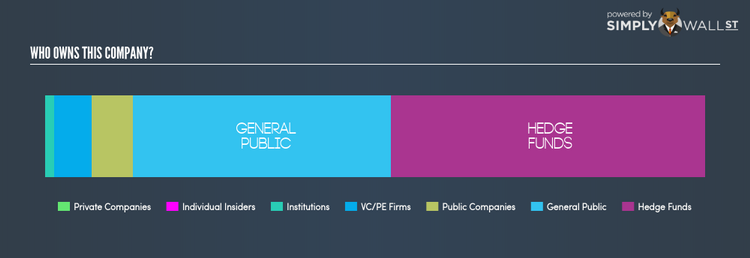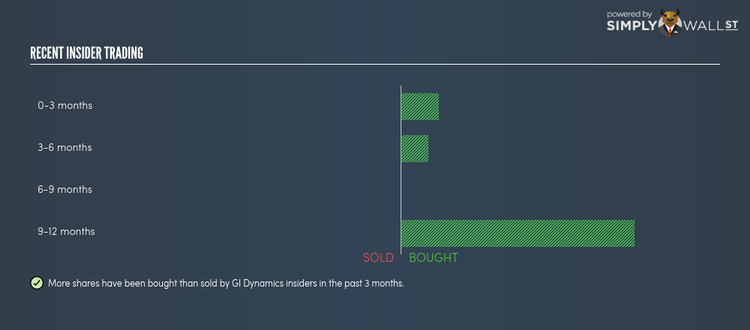Who Are The Largest Shareholders In GI Dynamics Inc (ASX:GID)?

In this analysis, my focus will be on developing a perspective on GI Dynamics Inc’s (ASX:GID) latest ownership structure, a less discussed, but important factor. Ownership structure has been found to have an impact on shareholder returns in both short- and long-term. Differences in ownership structure of companies can have a profound effect on how management’s incentives are aligned with shareholder returns, which is why we’ll take a moment to analyse GID’s shareholder registry.
View our latest analysis for GI Dynamics
Institutional Ownership
Due to the big order sizes of institutional investors, a company’s shares can experience large, one-sided momentum, driven by high volume of shares removed from, or injected into, the market. With a not-so-big institutional ownership of 1.46%, GID is not too exposed to price volatility that may arise from institutional trading. But another factor to consider is the presence of hedge funds, who are notorious for active investing. In GID’s case, they make up 47.47% of ownership, indicating potential sharp stock price movements during significant transactions. However, I would also examine the rest of its ownership structure in more detail to determine how the company’s major shareholders can affect its investment case.
Insider Ownership
Another important group of shareholders are company insiders. Insider ownership has to do more with how the company is managed and less to do with the direct impact of the magnitude of shares trading on the market. With a minor stake in GID, insiders seem to have some alignment of interest with shareholders. A higher level of insider ownership has been found to reflect the choosing of projects with higher return on investments compared to lower returning projects for the sake of expansion. It would also be interesting to check what insiders have been doing with their shareholding recently. Insider buying can be a positive indicator of future performance, but a selling decision can be simply driven by personal financial requirements.
General Public Ownership
The general public holds a substantial 39.07% stake in GID, making it a highly popular stock among retail investors. This size of ownership gives retail investors collective power in deciding on major policy decisions such as executive compensation, appointment of directors and acquisitions of businesses. This level of ownership gives retail investors the power to sway key policy decisions such as board composition, executive compensation, and potential acquisitions. This is a positive sign for an investor who wants to be involved in key decision-making of the company.
Private Equity Ownership
With a stake of 5.63%, private equity firms form another important class of owners in GID. With a stake of 5.63%, they can influence GID’s key policy decisions. This is an encouraging sign for investors as these investors tend to be active strategist in companies, focusing on increasing operational and capital efficiency for the firm.
Public Company Ownership
Potential investors in GID should also look at another important group of investors: other public companies, with a stake of 6.34%, who are primarily invested because of strategic and capital gain interests. An ownership of this size indicates a strong financial backing and has the potential to influence GID’s business strategy. Thus, investors should dig deeper into GID’s business relations with these companies and how it can affect shareholder returns in the long-term.
Next Steps:
While GID has a low level of institutional ownership, active hedge funds still hold a significant stake in the company. Their ownership is a non-fundamental factor, which can impact GID’s price volatility in the short-term, considering this group investors may come under pressure to deliver in the short term. A factor to consider is whether GID offers enough margin of safety compared to its intrinsic value. However, ownership structure should not be the only focus of your research when constructing an investment thesis around GID. Rather, you should be examining fundamental factors such as GI Dynamics’s past track record and financial health. I highly recommend you to complete your research by taking a look at the following:
Financial Health: Is GID’s operations financially sustainable? Balance sheets can be hard to analyze, which is why we’ve done it for you. Check out our financial health checks here.
Past Track Record: Has GID been consistently performing well irrespective of the ups and downs in the market? Go into more detail in the past performance analysis and take a look at the free visual representations of GID’s historicals for more clarity.
Other High-Performing Stocks: Are there other stocks that provide better prospects with proven track records? Explore our free list of these great stocks here.
NB: Figures in this article are calculated using data from the last twelve months, which refer to the 12-month period ending on the last date of the month the financial statement is dated. This may not be consistent with full year annual report figures.
To help readers see pass the short term volatility of the financial market, we aim to bring you a long-term focused research analysis purely driven by fundamental data. Note that our analysis does not factor in the latest price sensitive company announcements.
The author is an independent contributor and at the time of publication had no position in the stocks mentioned.

 Yahoo Finance
Yahoo Finance 

